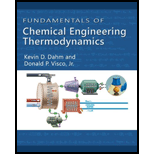
(A)
Interpretation:
The minimum pump work done to move 1 kg of water into tower
Concept Introduction:
The expression to calculate the height of the tower.
Here, height of tower is H, diameter of tower is D, and volume of the water in the tower is V.
The expression to calculate the work done.
Here, force is F, distance is d, mass is m, and acceleration is a.
(B)
Interpretation:
The minimum pump work done to move 1 kg of water into tower
Concept Introduction:
The expression to calculate the work done.
Here, force is F, distance is d, mass is m, and acceleration is a.
(C)
Interpretation:
The maximum velocity the water can have is
Concept Introduction:
The steady state energy balance equation for steam around the cylinder.
Here, mass flow rate for inlet and outlet is
(D)
Interpretation:
The maximum velocity the water can have is
Concept Introduction:
Write the steady state energy balance equation for steam around the cylinder.
Here, mass flow rate for inlet and outlet is
Want to see the full answer?
Check out a sample textbook solution
Chapter 3 Solutions
Fundamentals of Chemical Engineering Thermodynamics (MindTap Course List)
 Introduction to Chemical Engineering Thermodynami...Chemical EngineeringISBN:9781259696527Author:J.M. Smith Termodinamica en ingenieria quimica, Hendrick C Van Ness, Michael Abbott, Mark SwihartPublisher:McGraw-Hill Education
Introduction to Chemical Engineering Thermodynami...Chemical EngineeringISBN:9781259696527Author:J.M. Smith Termodinamica en ingenieria quimica, Hendrick C Van Ness, Michael Abbott, Mark SwihartPublisher:McGraw-Hill Education Elementary Principles of Chemical Processes, Bind...Chemical EngineeringISBN:9781118431221Author:Richard M. Felder, Ronald W. Rousseau, Lisa G. BullardPublisher:WILEY
Elementary Principles of Chemical Processes, Bind...Chemical EngineeringISBN:9781118431221Author:Richard M. Felder, Ronald W. Rousseau, Lisa G. BullardPublisher:WILEY Elements of Chemical Reaction Engineering (5th Ed...Chemical EngineeringISBN:9780133887518Author:H. Scott FoglerPublisher:Prentice Hall
Elements of Chemical Reaction Engineering (5th Ed...Chemical EngineeringISBN:9780133887518Author:H. Scott FoglerPublisher:Prentice Hall
 Industrial Plastics: Theory and ApplicationsChemical EngineeringISBN:9781285061238Author:Lokensgard, ErikPublisher:Delmar Cengage Learning
Industrial Plastics: Theory and ApplicationsChemical EngineeringISBN:9781285061238Author:Lokensgard, ErikPublisher:Delmar Cengage Learning Unit Operations of Chemical EngineeringChemical EngineeringISBN:9780072848236Author:Warren McCabe, Julian C. Smith, Peter HarriottPublisher:McGraw-Hill Companies, The
Unit Operations of Chemical EngineeringChemical EngineeringISBN:9780072848236Author:Warren McCabe, Julian C. Smith, Peter HarriottPublisher:McGraw-Hill Companies, The





